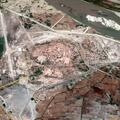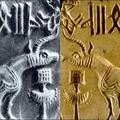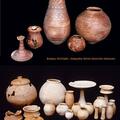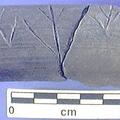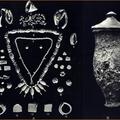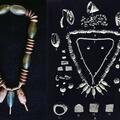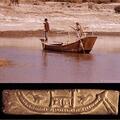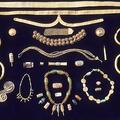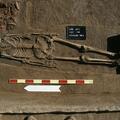This unique discovery of a coiled copper-alloy wire necklace (H2000/2242-01) dating to Harappa period 3B (circa 2450-2200 BC) is the earliest evidence for silk in South Asia. It has traces of fibers preserved on the inside.
343 posts, also carried on our Facebook page, about the ancient Indus Valley civilization, including important news, research and occasional visits to museums with ancient Indus artifacts.
Sep 17, 2014
A perfect unicorn seal found in Trench 49E, Harappa. The craftsmanship and balance of the three fish signs, the arrow and two strokes with the so-called unicorn's head and sacred relic is remarkable. Excavations in 1997 at the southeast corner of the Mound F
Sep 11, 2014
Although there is no evidence to suggest that Mound F at Harappa or the "granary" at Mohenjo-daro (illustrated above) actually were granaries, this theory by archaeologists like Sir Mortimer Wheeler has taken hold in the public imagination.
Sep 8, 2014
The phantasm by Sir Mortimer Wheeler (Image 1) , a diagram of the structure by John Marshall (Image 2), photographs by Jonathan Mark Kenoyer and Richard H (Image 3 and 4). The basic function of this structure on Mound F - there is also one in Mohenjo-daro -
Sep 6, 2014
A portion of a large brick drain excavated at Harappa that survived the brick robbers. Dating to about 2400-2200 BCE, it was later filled in and the area leveled.
Sep 3, 2014
"Originally, the site of Mohenjo-daro must have been much more extensive than it is today and have formed a more closely connected whole, but water and wind, aided by the action of salt in the soil and the extreme aridity of the climate, have combined to eat
Sep 2, 2014
Large square unicorn sealing (left) and seal from Mohenjo-daro. The unicorn is the most common motif on Indus seals and appears to represent a mythical animal that Greek and Roman sources trace back to the Indian subcontinent.
Aug 28, 2014
From the southern steps of the Great Bath showing recesses for wooden treads and stairways to platforms of some among the 700 wells in Mohenjo-daro, glimpses of where the ancient Indus people trod every day.
"A curious feature of the two stairways leading
Aug 25, 2014
Painted and unpainted burial pottery from Harappa. The two largest vessels were found in the same burial and are described below. The other smaller vessels were found in an earlier burial and represent an older style of pottery.
Aug 23, 2014
The origins of Indus writing can now be traced as far back as the Ravi Phase (c. 3300-2800 BCE) at Harappa. Some inscriptions were made on the bottom of the pottery before firing. Other inscriptions such as this one were made after firing. This inscription (c.
Aug 21, 2014
John Marshall writes about one of the greatest of Indus finds, "the jewelry illustrated ... was found in the silver vessel illustrated on the right of the plate, which was unearthed by Mr.
Aug 19, 2014
Among the tragedies of partition was the literal breaking apart of one of the finest necklaces from Mohenjo-daro, with half going to India and half to Pakistan.
Aug 13, 2014
A molded tablet from Mohenjo-daro ca. 2300 BCE, below while above, flat bottomed ferry boats are still used today to help travelers cross the Indus River near Mohenjo-daro.
Aug 8, 2014
Gold and agate ornaments includes objects found at both Mohenjo-daro and Harappa. At the top are fillets of finely burnished hammered gold that would have been worn around the forehead.
Aug 5, 2014
The body may have been wrapped in a shroud, and was then placed inside a wooden coffin, which was entombed in a rectangular pit surrounded with burial offerings in pottery vessels.

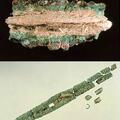
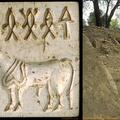
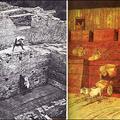
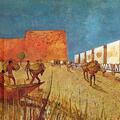
![This view along Drain [8] into the mound shows details of the brick construction, the robbed out area at the east end of the drain (background), sloping strata above indicating the existence of an open street drain along the same line as the earlier baked brick drain, and the later Period 3C architecture built after the open drain was filled in and the area leveled. The bricks from the eastern part of the drain were robbed by tunneling into the sediment along the line of the drain from the East.](https://www.harappa.com/sites/default/files/styles/square_thumbnail/public/10603722_10152727995099846_3192098744717677416_n.jpg)
